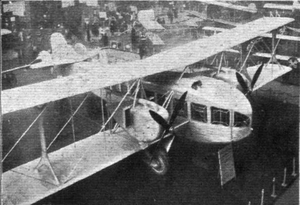Breguet 22
| Breguet 22 Leviathan | |
|---|---|
 | |
| Role | 22-seat, twin-engine airliner |
| National origin | France |
| Manufacturer | Société Anonyme des Ateliers d'Aviation Louis Breguet |
| First flight | 1922-23 |
| Number built | 1 |
| Developed from | Breguet 20 |
The Breguet 22 or Breguet XXII was a prototype passenger aircraft built in France in the early 1920s. It had two double engines and seats for about twenty people but was destroyed in 1923 during a transport aircraft competition.
Development and design
In 1922 Breguet Aviation flew both their all-metal Breguet 19, a bomber/reconnaissance aircraft and the Breguet 20. The latter was another all-metal biplane but much larger and powered by two Breguet-Bugatti U.16 " double" engines, each a pair of water cooled straight-eight engines with a single output shaft. The engines were placed centrally in the fuselage and drove a nose-mounted single propeller through a long shaft.[1][2] Unlike the very successful Breguet 19, the Breguet 20 proved unsatisfactory and was developed into the otherwise very similar Breguet 22, which had a pair of Breguet-Bugatti U.16s mounted between the wings on either side.[2] Since the double engines could continue to run with one half shut down,[2] both the Breguet 20 and 22 were sometimes referred to as four-engined aircraft (e.g.L'Aerophile[3]). Moving the engines from the fuselage to the wings freed the fuselage for a passenger cabin which could hold 22, a large number in those days. Both the Type 20 and Type 22 were referred to as the Breguet Leviathan by contemporaries.[3][4]
The fuselages of the Types 20 and 22 were similar flat-sided structures based on four cross-braced longerons, each of three parts. Since the nose of the 22 did not terminate in a propeller, the high cockpit of the 20 was replaced with a blunt-nosed cabin, curved in planform, for the pilot.[1] Behind him the passenger seats in the Type 22 were in pairs, each with their own window. Boarding and disembarking were reported as a little difficult.[2][3] The wing-mounted engines led to revised wing plans and structures. The Breguet 22 had equal-span, unstaggered wings of rectangular plan and three bays. The innermost bay was defined by the engine by the engine mountings, which placed the U.16s with their four-blade tractor propellers on multiple struts midway between the two wings. Radiators were mounted on the sides of the engine cowling. The outer bays were formed by single interplane struts with forked junctions into the wings, assisted by cross-bracing. At the rear the tail was, like that of the Type 20, quite small and conventional with the tailplane mounted on top of the fuselage but now carrying a pair of small additional fins. The landing gear was also conventional, with each fixed mainwheel mounted on a pair of substantial V-form legs from the wing spars under the inner bay.[2]
The Breguet-Bugatti engines soon proved unreliable and by early 1923 the Type 22 was described as powered by four Lorraine engines.[5] These were water cooled, V-8, 270 hp (200 kW) units mounted in puller/pusher pairs.[6]
The sole Type 22 was destroyed in a fire following a forced landing in mid-September 1923 whilst competing for the Grand Prix pour Avions de Transport.[7]

Specifications (Breguet-Bugatti engines)
Data from L'Aérophile, January 1923[8]
General characteristics
- Capacity: 25 including crew, some other sources put the number around 22 + pilot
- Length: 14.02 m (46 ft 0 in)
- Wingspan: 25.54 m (83 ft 10 in)
- Height: 5.13 m (16 ft 10 in)
- Wing area: 140 m2 (1,500 sq ft)
- Empty weight: 3,150 kg (6,945 lb)
- Gross weight: 6,400 kg (14,110 lb)
- Fuel capacity: 1,500 l (330 imp gal; 396 US gal)<Learo1/>
- Powerplant: 2 × Breguet-Bugatti U.16 U-16, two straight-eight engines in parallel, 360 kW (480 hp) each [2][3]
- Propellers: 4-bladed [2]
Performance
- Maximum speed: 170 km/h (106 mph; 92 kn)
- Range: 1,100 km (684 mi; 594 nmi) [3]
- Service ceiling: 4,000 m (13,000 ft)
References
- 1 2 "Breguet Leviathan". L'Aérophile: 8–9. 1–15 July 1922.
- 1 2 3 4 5 6 7 "Louis Breguet - Paris". Flight. Vol. XIV no. 52. 28 December 1922. pp. 784–5.
- 1 2 3 4 5 "Les Avions Stand par Stand - Breguet "Leviathan" XXII". L'Aérophile: 8–9. 15 December 1922 – 1 January 1923.
- ↑ "The Paris Aero Show". Flight. Vol. XIV no. 51. 21 December 1922. p. 762.
- ↑ "Note". L'Aérophile. 31: 137. 1–15 March 1923.
- ↑ "Le Grand Prix des Avions de Transport". L'Aérophile. 31: 291–2. 1–15 October 1923.
- ↑ "Les Grandes Épreuvres de l'Année". L'Aérophile. 32. 1–15 February 1924.
- ↑ "Les Avions du VIII Salon de l'L'Aéronautique". L'Aérophile. 31: XVIII. 1–15 January 1923.